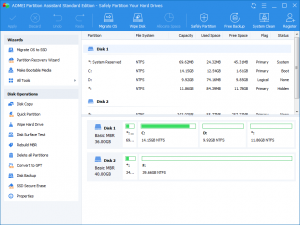Brief introduction to RAID
RAID is standing for redundant array of inexpensive drives/disks, which means series of hard drives/drives like a super hard drive. RAID is a solution that was developed originally for the network server market as a way of creating large storage at a lower cost. As time went by, it puts multiple lower cost hard drives together through a controller to provide a single larger capacity drive.
RAID is a way of storing the same data in different places on multiple hard disks, and most of the systems used a single drive to store data before RAID devices became popular. Five of RAID levels are commonly used, they are:
- RAID 0: It has striping but no redundancy of data and offers the best performance but no fault-tolerance.
- RAID 1: This type is also known as disk mirroring and consists of more than two drives that duplicate the storage of data. It provides the best performance and the best fault-tolerance in a multi-user system.
- RAID 5: It stores parity information but no redundant data and requires at least three and usually five disks for the array.
- RAID 10: In this type, data is organized as stripes across multiple disks, and the striped disk sets are mirrored.
Besides all above, there are more levels: RAID 2, RAID 3, RAID 4, RAID 6, RAID 7, etc. All of them have different functions and do different things.
Function of RAID levels
RAID levels storage now can be used for three distinct purposes, including:
Capacity: Capacity is a simple one that is especially involved in most every type of RAID setup used. For example, two hard drives can be linked together as a single drive to the OS effectively making a virtual drive that is twice the capacity.
Security: RAID levels can be used for data security by using some of the space on the drives to essentially clone the data that is written to both drives. Once again, with two drives you can make it so that the data is written to both drives.
Performance: Performance is another key reason for using a RAID setup on a personal computer. Also, RAID levels can be used for data security by using some of the space on the drives to essentially clone the data that is written to both drives. Once again, with two drives you can make it so that the data is written to both drives.
Glossary of RAID levels
In order to further understand RAID levels, we need to learn the three main glossaries of RAID:
- Data Striping: It is a technique for writing and reading data sequentially to more than one storage device. The blocks of data and then written sequentially to all disks simultaneously into areas called stripes.
- Disk Mirroring: It creates a mirror image of the information of one disk onto another. The data is written to both disks at the same time, if one disk fails then the mirror disk can be utilized immediately to provide requested data restore the lost data.
- Parity Fault Tolerance: It works by performing a logical operation on the data as it stores it and writing the result of this operation to either a dedicated disk or on the main data disks.
As RAID partition manager, AOMEI Partition Assistant can help you manage RAID hard disk partition easily and safely.
AOMEI Partition Assistant Screenshot
Related Articles:
* Convert to Dynamic Disk with Powerful Software
* How to Solve Dynamic Disk Invalid Problem?
* Best Free Partition Software for Windows 8/7/Vista/XP Users
* RAID Hard Drive Partition Overview and Management: Resize and Extend
* Magic and Easy Partition Manager Software for Hard Disk Partition Management
* Solve System Disk Full for Windows 2003 with Free Server Partition Magic
* Manage Windows Small Business Server 2003 Partition with AOMEI Partition Assistant Server Edition
* The Best Windows Server 2003 Restore Software for System Recovery
* Schedule Backup Windows Server 2003, 2008, 2012 with Free AOMEI Backupper
* Create Hard Disk Partition Manager Software Bootable CD/DVD in AOMEI PE Builder
* Create Backup Freeware Bootable CD/DVD with AOMEI PE Builder